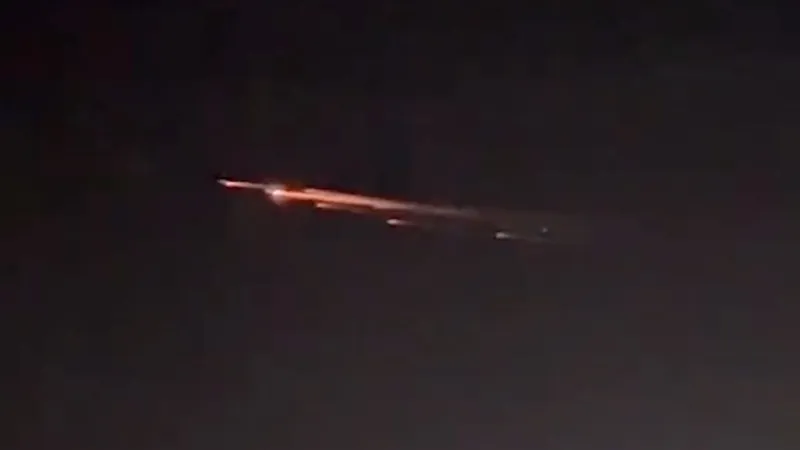
Kessler Syndrome: Are We On the Brink of a Space Disaster Due to Orbiting Debris?
2024-12-27
Author: Yu
Space enthusiasts and scientists alike are sounding alarms over a growing menace in Earth's orbit: space debris. The concern came to light recently when a piece of orbiting junk threatened the International Space Station (ISS). In November, the ISS crew, consisting of seven astronauts, faced a potential disaster when debris was forecasted to come frighteningly close—within 2.5 miles—of their orbit. Thanks to a timely maneuver by a Russian spacecraft, the station was able to dodge danger, but the incident highlights a much larger problem that is escalating rapidly.
The Rising Tide of Space Junk
Since its inception in 2000, the ISS has had to alter its course numerous times to avoid collisions, with the frequency of these course adjustments increasing alarmingly. Experts estimate that there are tens of thousands of traceable bits of debris, with millions more existing undetected, resulting from past satellite crashes, explosions, and military tests. The situation has reached a critical juncture, with Dr. Vishnu Reddy from the University of Arizona warning that we are edging closer to a tipping point known as Kessler Syndrome— a concept introduced by astrophysicist Donald Kessler.
What is Kessler Syndrome?
Kessler Syndrome refers to a catastrophic domino effect where one collision in space triggers subsequent collisions, creating a cascade of debris that could render specific orbits unusable for satellites and spacecraft. This phenomenon poses severe risks not just to astronauts aboard the ISS but also to the satellites that provide essential services such as GPS, telecommunications, and weather forecasting.
The Collision Landscape
According to the European Space Agency, since spaceflight began in 1957, there have been over 650 notable incidents involving the fragmentation of existing space objects, due to collisions and explosions. High-profile examples include the 2009 crash between the defunct Russian satellite Kosmos 2251 and the active communications satellite Iridium 33, which resulted in about 2,000 pieces of debris. Meanwhile, in December, another U.S. satellite broke apart, generating additional fragments, illustrating how often these events occur.
Predicting the Future: The Challenge of Orbital Monitoring
Managing space traffic has become increasingly complex. Satellite operators often receive multiple alerts daily regarding potential collisions. However, only objects larger than a tennis ball can presently be monitored reliably. Anything smaller remains elusive, making it difficult to predict potential hazards. Even small pieces of junk can cause catastrophic damage due to the high velocities at which they travel.
Risk by Orbital Altitude
Low-Earth orbit (LEO), which is home to the ISS and vast satellite constellations, is the most congested area in space. If a significant collision event were to unfold in this area, the ramifications could halt future space missions and destroy vital satellite services. Worryingly, the situation gets even bleaker in higher orbits, such as geostationary orbit (GEO), where debris can persist for centuries due to a lack of atmospheric drag.
Is Kessler Syndrome Already Happening?
Experts disagree on whether Kessler Syndrome is already underway. While some contend that the number of incidents suggests a worsening state, others are unsure if the point of no return has been reached yet. Nevertheless, there is a consensus that without decisive action to mitigate risks, the proliferation of debris will continue unabated.
Solutions on the Horizon
The conversation is shifting toward potential solutions for debris mitigation and cleanup. Technologies like the Drag Augmentation Deorbiting Subsystem (ADEO) are in development, which aims to bring defunct satellites back into the atmosphere to burn up harmlessly. However, funding and practical implementation for such technologies remain unresolved challenges.
Moreover, the establishment of international regulations to govern space activities is paramount. In a recent move, the United Nations adopted the "Pact for the Future," emphasizing the need for discussions on frameworks to tackle space traffic and debris. However, the lack of enforcement mechanisms leaves many skeptics doubting effective implementation.
Conclusion: The Clock is Ticking
As space traffic experts ponder solutions, there is a palpable sense of urgency to act. The increasing congestion in Earth's orbit is reminiscent of environmental issues we face on Earth, such as plastic pollution in our oceans. Just as we must address waste management on our planet, a proactive approach is critically needed to ensure the clean and sustainable future of space exploration.
The question remains: Will we rise to the challenge before it's too late? Only time will tell.




 Brasil (PT)
Brasil (PT)
 Canada (EN)
Canada (EN)
 Chile (ES)
Chile (ES)
 España (ES)
España (ES)
 France (FR)
France (FR)
 Hong Kong (EN)
Hong Kong (EN)
 Italia (IT)
Italia (IT)
 日本 (JA)
日本 (JA)
 Magyarország (HU)
Magyarország (HU)
 Norge (NO)
Norge (NO)
 Polska (PL)
Polska (PL)
 Schweiz (DE)
Schweiz (DE)
 Singapore (EN)
Singapore (EN)
 Sverige (SV)
Sverige (SV)
 Suomi (FI)
Suomi (FI)
 Türkiye (TR)
Türkiye (TR)